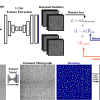Multiple-image super-resolution of cryo-electron micrographs based on deep internal learning
Single-particle cryo-electron microscopy (cryo-EM) is a powerful imaging modality capable of visualizing proteins and macromolecular complexes at near-atomic resolution. The low electron-doses used to prevent radiation damage to the biological samples, however, result in images where the power of the noise is 100 times greater than the power of the signal. To overcome these low signal-to-noise ratios (SNRs), hundreds of thousands of particle projections are averaged to determine the three-dimensional structure of the molecule of interest. The sampling requirements of high-resolution imaging impose limitations on the pixel sizes that can be used for acquisition, limiting the size of the field of view and requiring data collection sessions of several days to accumulate sufficient numbers of particles. Meanwhile, recent image super-resolution (SR) techniques based on neural networks have shown state-of-the-art performance on natural images. Building on these advances, here, we present a multiple-image SR algorithm based on deep internal learning designed specifically to work under low-SNR conditions. Our approach leverages the internal image statistics of cryo-EM movies and does not require training on ground-truth data. When applied to single-particle datasets of apoferritin and T20S proteasome, we show that the resolution of the 3D structure obtained from SR micrographs can surpass the limits imposed by the imaging system. Our results indicate that the combination of low magnification imaging with in silico image SR has the potential to accelerate cryo-EM data collection by virtue of including more particles in each exposure and doing so without sacrificing resolution.






